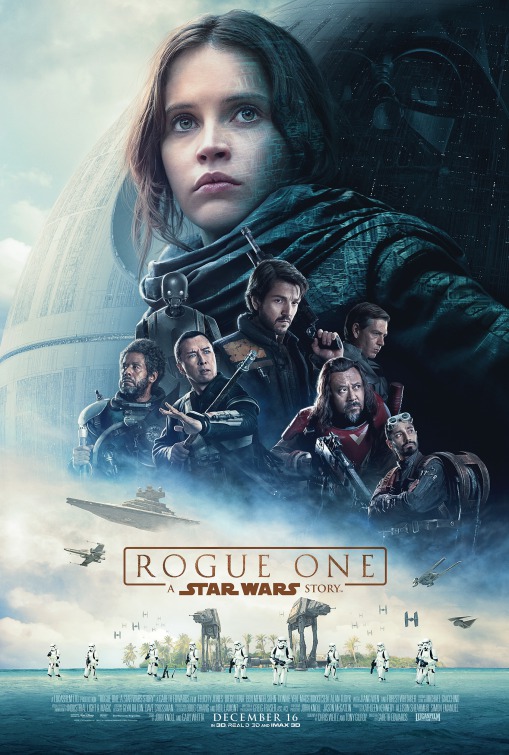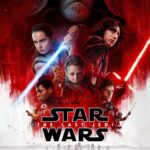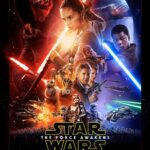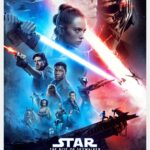A Rebellion Built On Hope
Director
Gareth Edwards
Starring
Felicity Jones
Diego Luna
Ben Mendelsohn
**Fair warning, this entire review is filled with spoilers. In order to have a proper analytical breakdown we need to discuss various aspects that some would prefer not to know until they’ve seen the film. As such, don’t read this until you’ve watched it. Consider yourself warned**
Rogue One opens with the Galactic Empire tracking down one of their leading scientists, Galen Erso [Mads Mikkelsen], who has gone into hiding to live a simple life. Director Krennic [Mendelsohn] knows how close they are to completing the greatest weapon the universe has ever known but he requires Galen to finish it. Refusing to come willingly, Krennic executes Galen’s wife and would have done the same to his young daughter, Jyn, but his troopers are unable to locate her. Fifteen years later (a mere few days before the events of Star Wars) Jyn Erso [Jones] has grown up and continues to resist the Empire’s control as a petty criminal. Through a network of spies and defectors, word has reached the Rebellion that an Imperial pilot, Bodhi Rook [Riz Ahmed], has a message from Galen about a new weapon being developed which would change the course of the war. Rebel intelligence officer, Cassian Andor [Luna], breaks Jyn out of prison and brings her before the Rebel council who contract her to make contact with a previous ally to authenticate the pilot’s claim and retrieve the plans if they exist. This sets in motion a series of events which sees a misfit band of provocateurs risking life and limb infiltrating installations deep in the heart of Imperial territory.
In many ways, Rogue One owes a lot of its success to the prequels and the expanded universe fiction that has grown over the decades. With George Lucas’ attempts to fill in backstory elements over three features, it’s been clearly illustrated how not to do a Star Wars film; or more accurately what the public do and do not approve of. Furthermore it’s hard to think of any franchise other than Star Wars that has been so extensively repurposed, reinterpreted and used as a base of inspiration for so many mediums: video games, board games, artwork, books, TV series, animations, comics, fan fiction, short films, etc. I bring this up as the RPG board game Imperial Assault shares a great many similar qualities, all of which are welcome additions.
A lot of people will immediately say this is very much a war film, more than that, it’s the first Star Wars film to really focus on the ‘war’ part of Star Wars. Admittedly, I wouldn’t go that far but it maturely portrays the unglorified side of war that doesn’t follow the quirky hero who literally dodges bullets, epically wins it for the universe and makes it home in time for tea.. or blue milk. Drawing identifiable parallels with real military conflicts (although one could argue the West is the evil Empire in that example) Rogue One succeeds in illustrating that in war, there are only shades of grey and compromise to protect your interests. The divide between good guy and bad guy is completely blurred, acknowledging that not every villain is a willing participant and not every hero does noble deeds. This is an incredibly strong and welcome move. If there’s one thing Star Wars needs, it’s to be able to say to a whole swathe of the public, “these movies are not just for children.” I always maintain two of the easiest fixes that could be applied to Episode I: The Phantom Menace would be to show Naboo’s occupation and get rid of the robots. Amidst the poop jokes and casual racism, the following line of dialogue is uttered, “the death toll is catastrophic.” Living in a time when the death toll in somewhere like Syria is genuinely catastrophic it’s hard to look back on that palatial world and see any true suffering. Rogue One finally illustrates the pain of this universe, which in turn leads audiences to invest and care about those risking their lives to save it, not whiny children and back flipping idiots. Which leads me to those fucking droids. An army of autonomous robots who can be chopped to pieces means you can get away with murdering scores of beings without moral culpability and removes any genuine weight to the decision to act. Here we don’t have Jedi with force powers and lightsabers to deflect laser blasts, we have conscripted uniformed soldiers shooting at desperate rebels, both sides doing their best to avoid dying and living with the consequences of taking lives. It’s an absolutely necessary humanising element that doesn’t sensationalise war and shows the emotional toll on these people.
Speaking of the people in question, I genuinely loved the cast. Too many trolls will whine about a female-led film or the lack of white males but I didn’t care. Drawing on fantasy archetypes, we have the big-heavy, the mystic, the thief, the rogue, the cavalier leader and the sardonic straight-talking outsider. I also love that the film addresses bureaucracy (without delving into the compelling world of trade disputes), with a bickering Rebel command and cutthroat villainy in the upper echelons of the Empire. We’re all too acquainted with Vader force-choking various Admirals and the Emperor’s scheming but watching the infighting and backstabbing that takes place is enjoyable. The acting was solid and the characters believable and interesting enough to hold my attention – although I will expand on that later – but the real talking point and one that took me by surprise was not in fact about the living cast but the dead. One of the reasonably well kept secrets is the use of CGI facemasks, giving us a young Carrie Fisher and a resurrected Peter Cushing. I have no doubt that many reviewers and audience members will agonise over the moral and ethical question of whether using the representation of a long deceased actor is appropriate. My argument would only really be the quality of the computer generated work on display (to which I would say it’s incredibly impressive and other than a few rubbery moments, is very well handled – except Leia, they didn’t need to hold on that shot for so long). Now, the reason I am completely indifferent to the idea of using Cushing is Audrey Hepburn; specifically Audrey Hepburn selling Galaxy chocolate. For those that don’t know, a few years ago an ad campaign was launched utilising Hepburn’s likeness to sell a brand of chocolate bar. The ad is arguably inoffensive and very much in the vein of Hepburn’s previous works. The second the public was ok with that, everything was fair game and to my mind, I am rather excited by the prospect. I don’t think we need to be chucking Orson Welles into every other film just for the sake of it but where “needed” I view this method as the natural evolution and continuing transition between theatre and cinema. Hiring different actors to play different aged characters is an oddity we accept as necessity. Obviously we can’t show a young Brad Pitt because the actor is pushing towards his fifties, we’ll just hire someone who looks a bit like him. Oh what’s that? Technology says it’s feasible? Cue Benjamin Button. Rogue One proves this technology has a great deal of potential but like all cinematic leaps, it will only thrive in the right hands.
Alright, that’s enough fawning, time to eviscerate this beast. Rogue One is a great film but it’s far from perfect. Walking out of the opening night screenings there was such an air of positivity with people claiming it was the best Star Wars film. So let’s just pump the breaks a little and axe the hyperbole. The narrative of this film has already been summarised in a single sentence in the opening crawl of the first film, subsequently it lacks an ending because it’s a precursor to the main story. Sure, it fills in a lot of gaps and allows audiences to truly revisit the Star Wars they nostalgically love (rather than a preceding or proceeding time period) but it still builds on an already strong foundation. What’s more it creates tension solely for the purpose and then convolutes itself in the process. On the positive side, this allows writers to officially retcon Lucas’ plot holes but simultaneously creates bigger problems. Galen smuggles out a holographic message telling Jyn about the Death Star’s weakness. I appreciate the schematic plans are needed for precision but couldn’t he have just made a copy and snuck that out too? Secondly, a line of dialogue states that the Death Star drops out of hyperspeed to appear over Scarif. If it can just hyperspeed to places then why did it take so long to align with Yavin IV in A New Hope? I know there will be a pithy retort or explanation eventually but if you’re trying to fix problems, don’t actively create things that will create footnote/caveat issues later. We also have the Easter Eggs and nods to the original series which a lot of people will readily and happily consume but they are no more clever or subtle than the attempts made in the prequels. “Oh look! Look! It’s Cornelius Evazan and Ponda Baba from the cantina! I remember them? Wow!” Yes, I remember them too and I now have to think about the logistics of them not only bumping into Skywalker on Tattooine a couple of days later, they also have to get out of Jedha in an hour before the thing explodes! I’m sorry, I appreciate the references and name-drops but you can’t tell me they’re any more fulfilling than Jango Fett banging his head on the Slave 1 door or prepubescent Greedo watching podracing. Then we have Darth Vader and everyone will go ape shit for scary Vader cutting through rebels but that’s his second scene. The first is him in a bacta-tank before scolding Director Krennic. This is such a nitpick but I kept looking at his neckline and frowning. I couldn’t figure out what was wrong but finally realised it was that they a) made Vader far too bulky and hench and b) his cape covers his neckline which makes the bottom of the mask stand out and the whole effect felt reminiscent of an independent fan film. Bizzare. While we’re on supporting characters and cameos, the secondary leads aren’t developed nearly enough; I don’t think I could tell you much of anything about the other crew member’s backstories or motivations other than “Empire bad.” I will admit that sometimes avoiding all that exposition is decent and frees up time to invest in the ‘how’ of the goal rather than the intricacies of the ‘why’ but it’s frustrating when these individuals are genuinely interesting and warrant more exploration. Finally, we have Michael Giacchino. Mr. Giacchino always felt like the natural successor to the musical mantle but I was left disappointed. Bar Rey’s theme, Williams’ work on Episode VII was a little tame and lacked real presence and originality. Regrettably, Giacchino does the same thing by repeating his Jurassic World homage score that plays it too safe, adding nothing ground-breaking or memorable. Admittedly he was brought on at the last minute and he clearly laid out that the combination of Holst’s planets and the Flash Gordon serials as inspiration, so I can’t fault him too much.
Despite my apparent bashing of this film, it is a really entertaining, decent release but I maintain that every single Disney property release requires excessive scrutiny because they have all the money, access to all the talent and immense platforms for storytelling so there’s really no excuse for subpar achievements. Furthermore, as much as I moaned about the creation of new plot holes, Rogue One (and I’m assuming these other anthology tales) opens up an interesting realm of potential and possibilities, creating new worlds, species and Imperial plans to draw on and reference without always coming back to tiny throw away lines from the same three films from thirty plus years ago. As such, this mirrors the groundwork of Episode VII, growing and expanding the reach of future releases to provide satisfying stories for years to come.
Release Date:
16th December 2016
The Scene To Look Out For:
Ask any Star Wars fan what their favourite element of Rogue One was and you’ll probably get a flurry of moments. This isn’t a derogatory point, just a statement that this movie is littered with “it was so cool when..” developments. Personally, I have two and they’re both very simplistic. The first, chronologically, is the rebel bombing run. The Rebel Alliance is branded the supreme good guys, never an ounce of doubt that their cause is just and true. But in reality war is never that clean cut and there will always be orders, skirmishes and encounters that are calamitous. The bombing run on Edu (Edoo? Idu? ..whatever) highlights that mistakes will always be made and hindsight is a wonderful thing. The second this is far more indulgent, devoid of all pretentiousness. I like the bit where Vader’s Star Destroyer turns up as the rebels are trying to accelerate to hyperspeed and they splatter themselves on the bow like bugs on a windscreen. It’s very cool.
Notable Characters:
It should come as no surprise, to anyone who has seen the film, that K-2SO is my highlighted character. Affording a lot of wonderful opportunities to engage in humour, Alan Tudyk does an astounding job. One could say he’s the darker side of C3PO, with his light English accent, stat quipping and self-preservation but we all know that C3PO is the darker side of C3PO and the worst character in the Star Wars universe. In truth, it was a tough pick between the superbly acted Ben Mendelsohn as Krennic or Donnie Yen and Jiang Wen as the Chirrut/Baze combo but based on initial impressions alone, K-2SO stands above everyone else.
Highlighted Quote:
“You’re confusing peace with terror”
In A Few Words:
“An extremely sturdy prologue expansion but far from the standalone greatness that it purported itself to be”
Total Score: 3/5
![The Red Right Hand Movie Reviews [Matthew Stogdon]](https://reviews.theredrighthand.co.uk/wp-content/uploads/2021/12/cropped-header1.png)




